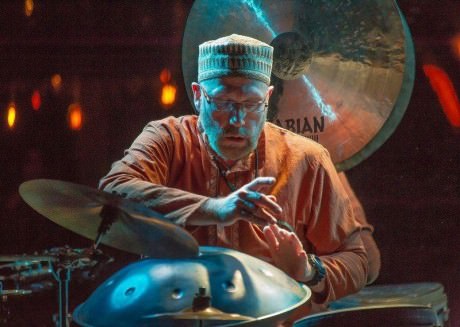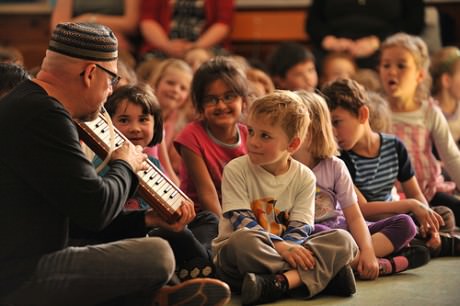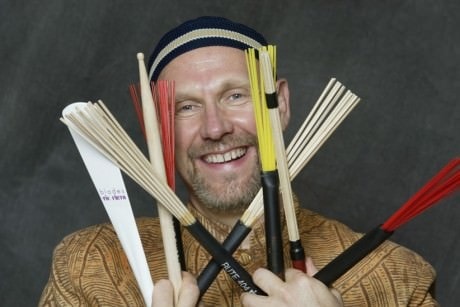Tom Teasley is not only a brilliant composer, musician, and performer, but he is one of the nicest people in our theatre community. He is full of passion and energy and watching him perform in a show is always an event! I asked Tom to talk about composing and performing his new score for The Folger’s The Conference of the Birds.
Joel: Why did you want to compose and perform the music for The Conference of the Birds at Folger Theatre?
Tom: I find the message in this work one of resounding universal truth. We are all looking for our purpose. We all have individual fears, doubts and ego that we battle along the way. I also find the inclusive nature of Sufism a compelling starting point for creating music as it lets me draw from a very wide gene pool of sound, rhythm and melody.

Take us through the process and journey of writing the score. Did working with Director Aaron Posner influence the score you wrote?
I can honestly say this process is and continues to be a journey. I began working on the score this past summer in very broad strokes with selection of instruments, soundscape, rhythms, melody and texture. Much like the rest of this process most of the final music is being created in the rehearsal process. Aaron is very sensitive to how the sound interacts and has had some amazing ideas. The cast and choreographer, Erika Chong Shuch, have also brought great ideas and concepts to the table.
What is unique about this score compared to your other scores we have heard at Constellation Stage?
The fact that the music is being created in the rehearsal process is different from my collaborations with Constellation. Most of the props are actually instrument that are being played by actors. So there is perhaps a bit more music (sound) being created on stage. I’m very fortunate to have Elisheba Ittoop working with me as an assistant sound designer. There will be an interesting mixture of very subtle prerecorded or performance initiated sound effects manipulated to give movement to nature sounds such as wind.
You are a Cultural Envoy for The US State Department? How have your many travels influenced your score?
My work as a Cultural Envoy has influenced the music as well as the process. My travels to the Middle East and beyond have given me a deep well to draw from in terms of traditional instruments, rhythms and melodies. When I travel for the St Department my agenda is to collaborate with the indigenous musicians for their respective audience. There is usually very little time to prepare a program. That openness and flexibility have proven very helpful in this process of creating a score while we discover the paths along this journey. I have a new CD, All The World’s A Stage, that is a representation of my Cultural Envoy work as well as my recent theater compositions.
Since you are a one-man-band, how many instruments will you be playing while performing your score for The Conference of the Birds?
The exact number hasn’t been determined but it will be around 10-15 different instruments.
And what instruments will you be playing?
Among the instruments will be a variety of frame drums (round hoop drums from a variety of cultures), doumbek (a goblet shaped drum from The Middle East) djembe (African Drum), melodica (breath generated wind piano), spring drum ( reverb sounding drum attached to a metal spring), aquasonic (water-filled drum with spokes that are bowed with a bass bow) hang drum (steel drum played with fingertips like a tabla), crotales (tuned antique cymbals), and cajons. Cajons are wooden box drums derived from shipping crates and will play an important role in this piece.

Any special instruments that you are utilizing for this production?
As I mentioned one interesting aspect of this production is the use of instruments as props. This will include 8 cajons that are played on stage by actors. A tumbi, one string banjo form North India, will be used as a bow on stage. A kilimba, thumb piano, will be used as a prop for a comb. I’ll be playing the crotales, tuned antique cymbals, at various points for the references of reflection. I’ll also be using the hang drum which is similar to a steel pan for those moments that denote magic and mystery. I can safely say this will be quite a sonic feast.
Tell us about this stage adaptation and the Persian poem it’s based on.How did the original poem influence the musical themes you are utilizing in your score?–
It’s very interesting. There are a variety of adventure stories which occur that are very conducive to text painting in a literal way.Text painting is the use of literal sounds that represent the text. There is also the overall message of the poem that ties all of the stories together. This message is self discovery forged by experience. So I’m frequently attempting to text paint a story in literal terms while hinting at the message that ties them all together.
You are working with a very talented cast. Have you worked with any of them before?
This is my first time working everyone in this cast. I feel very fortunate to have expanded my circle of colleagues and friends to include these talented people.
And what has delighted you so far about their performances?
I’m delighted at how musical the cast is. As I mentioned they are going to be playing a variety of instruments. hey are also going to be using konnakol, South Indian rhythmic speaking as well as singing. I should also mention that many great musical ideas have come from the cast. I am so enjoying their musicality and creativity!
What scenes were the most challenging to compose music for and why were they challenging?
There are some very fluid flight moments that are also very asymmetrical. It’s an interesting opportunity ground the time while portraying the fluidity of flight. Percussion is often thought of as being very articulate and staccato. I’m enjoying the opportunity to explore the fluidity and breath not often associated with percussion.
Your performances are very high energy. How do you keep up your energy during a run of one of your shows where you are performing the music?
It’s interesting that often people ask me that question. Since I tour the world as a solo percussionist, the physical stamina required for a theater run is much less than my solo performances, where I am literally performing non-stop. The mental energy required , however, is much greater. The stop and go nature of following visual and line cues I find to be much more exhausting than the performance itself. The choreography of changing instruments with little time while sounding, and looking, fluid is an interesting challenge. I’ll also be performing this show without a book which will add to the interest as well!
What do you want audiences to take with them after seeing The Conference of the Birds?
I think the goal of this work is to invite the audience to take this journey with us. Everyone will have different experiences that they use as points of reference for the various parables contained in this work. In a perfect world the audience will encounter these on their own terms and use each of these as points of reflection in their lives. My hope is for the music to provide an aural enhancement for this invitation.
I’d like to thank Aaron Posner for inviting me on this amazing journey. I’d also like the thank the great people at The Folger for all of their support.
For more information on me and my work please visit my website, or follow me on Facebook, or Twitter. Thank you so much for your interest in my work!
The Conference of the Birds plays through November 25, 2012 at Folger Theatre – 201 East Capitol Street, SE, in Washington, DC. For tickets, call the box office (202) 544–7077, or purchase them online.





